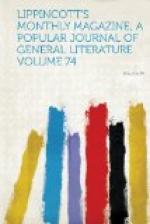The parties to any political or religious contest need a standard—some outward sign which appeals to the eye and the intelligence of all. The most serious of the political questions that convulse France to-day are symbolized and summed up in the color of a flag; and thus in the Russian conflict between popular obstinacy and the modern propagandism the rallying-sign of the Old Believers, and the emblem of the champions of nationality and conservatism, was the beard. The national chin was the centre of a conflict less puerile than might be fancied. Long before Peter the Great imitators of Western ways had begun to shave, thus setting at defiance the Oriental custom which everywhere prevailed in Russia. Under Peter’s father one of the Raskol leaders, the protopope Avvakum, denounced “these bold-faced” men—bold-faced meaning shaven. The prohibition of Leviticus (xxix. 27; xxi. 5) was first adduced, in conformity with the love for alleging religious scruples. Recourse was next had to the ancient missals and the decrees of the Stoglaf, a sort of ecclesiastical code attributed to a national council. The prohibition of the razor was at first confined to the clergy, but it spread by little and little to all the faithful of the orthodox Church. Up to the time of Nikon the patriarchs had laid hardly less stress on forms and on the exclusion of foreign ways than their future opponents of the Raskol, and had condemned shaving as “an heretical practice which disfigures the image of God, and makes men look like dogs and cats.” This is the main theological argument of the foes of the barber, and their current interpretation of the verse of Genesis, “God created man in His own image,” “The image of God is the beard,” writes a Raskolnik about 1830, “and His likeness is the moustache.” “Look at the old images of Christ and the saints,” urge the Old Believers: “all of them wear their beards.” And so cogent is the argument that the orthodox theologians are fain to hunt up




